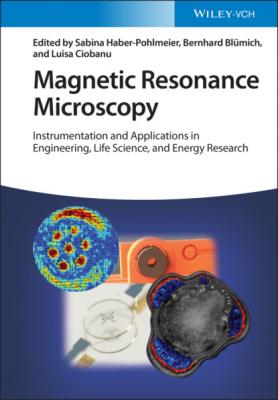Magnetic Resonance Microscopy. Группа авторов
Читать онлайн.| Название | Magnetic Resonance Microscopy |
|---|---|
| Автор произведения | Группа авторов |
| Жанр | Химия |
| Серия | |
| Издательство | Химия |
| Год выпуска | 0 |
| isbn | 9783527827251 |
374 361
375 362
376 363
377 364
378 365
379 366
380 367
381 368
382 369
383 370
384 371
385 372
386 373
387 374
388 375
389 376
390 377
391 378
392 379
393 380
394 381
395 382
396 383
397 384
398 385
399 386
400 387
401 388
402 389
403 390
404 391
405 392
406 393
407 394
408 395
409 396
410 397
411 398
412 399
413 400
414 401
415 402
416 403
417 404
418 405
419 406
420 407
421 408
422 409
423 410
424 411
425 412
426 413
427 414
428 415
429 416
430 417
431 418
432 419
433 420
434 421
435 422
436 423
437 424
438 425
439 426
440 427
441 428
442 429
443 430
444 431
445 432
446 433
447 434
448 435
449 436
450 437
451 438
452 439
453 440
454 441
455 442
456 443
457 444
458 445
459 446
460 447
461 448
462 449
463 450
464 451
465 452
Foreword
This book is the fourth in the Wiley-VCH series on Magnetic Resonance Microscopy, a series linked in spirit to the International Conference on Magnetic Resonance Microscopy (ICMRM). Winfried Kuhn and Bernhard Blümich organized the first meeting of this biannual conference in 1991 in Heidelberg, which led to the first book in this series. That Heidelberg meeting is also when Paul Callaghan burst upon the scene (with his student Yang Xia, who remains active in these meetings) with his new, but now classic, book Principles of Nuclear Magnetic Resonance Microscopy (Oxford University Press) – what timing! The wider appearance of magnetic gradient fields in the portfolio of magnetic resonance methods for imaging and studies of molecular transport phenomena was an exciting prospect. It motivated the still ongoing ICMRM conference series and the associated books, which summarize the progress in this field with chapters written by leading experts, among them Nobel Prize awardees Paul Lauterbur and Sir Peter Mansfield as well as Sir Paul Callaghan, who shaped that community like a force of nature from then on until his untimely death in 2012. Also, our brilliant colleague Robert Blinc from Slovenia attended the first ICMRM but had to leave early following an announcement during one of the sessions effectively saying “Professor Blinc, you are needed back in your country,” at which Robert Blinc stood up and left to facilitate the independence of Slovenia from Socialist Federal Republic of Yugoslavia. We were witnessing the birth of a country, a unique experience for most of us. At the third meeting in Würzburg, the brave suggestion to hold a meeting in North America was accepted. Thus, the fourth meeting was in Albuquerque and ICMRM has now a truly international presence, having ventured as far away as Utsunomiya and Beijing. These meetings, originally dubbed the Heidelberg Meetings, have been at the forefront of amazing developments and accompanying applications of magnetic resonance. Despite the inclusion of the word microscopy in their name, they represent the much broader area of magnetic resonance with spatial resolution, which is expressed by the title of the second book from the Albuquerque meeting, Spatially Resolved Magnetic Resonance, as well as the organizing Division of Spatially Resolved Magnetic Resonance of the AMPERE Society. Thanks to the advances over three decades, we have micrometer spatial resolution in magnetic resonance imaging today, while in the early days the word microscopy was understood as a tool to see things hard to visualize just by eye. We believe the broad range of the science and applications of magnetic resonance represented in these meetings is unique to all science and the field displays no hint of imminent stagnation – welcome news to all of us. I would like to close this Foreword with the observation that Bernhard Blümich, who with Winfried Kuhn founded these meetings 30 years ago, is still actively involved here as one of the editors of this book. I salute him for his continued contributions to the field and support of this conference.
Eiichi Fukushima
Albuquerque, 2021
Preface
Magnetic
